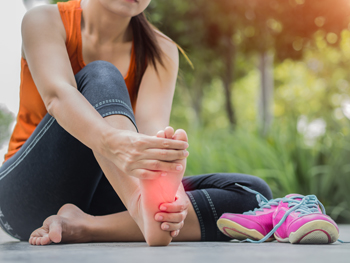Items filtered by date: June 2023
What Are the Symptoms of Poor Circulation?

Poor circulation can be common among older people. It is a condition that can affect the feet, and pain and discomfort may ensue. When circulation is good, existing wounds and cuts can heal quickly, and the body may be able to successfully ward off other ailments. Poor circulation is defined as a lack of oxygen that is needed by vital organs. Symptoms of poor circulation are often found in the feet and can consist of a tingling or numbing sensation. The feet may also be swollen, and the skin may become dry. Poor circulation can be caused by diabetes and atherosclerosis. This is a condition that causes a buildup of plaque in the arteries, and they can become narrow, possibly lessening blood flow. There can be additional health conditions that can lead to getting poor circulation, including smoking, consuming excess alcohol, and being overweight. Mild relief may be found when compression stockings are worn, and a gentle exercise routine is frequently performed. If you have poor circulation, it is suggested that you confer with a podiatrist who can offer you relief and treatment options.
While poor circulation itself isn’t a condition; it is a symptom of another underlying health condition you may have. If you have any concerns with poor circulation in your feet contact Dr. Tupper of Coshocton Foot Health Center. Our doctor will treat your foot and ankle needs.
Poor Circulation in the Feet
Peripheral artery disease (PAD) can potentially lead to poor circulation in the lower extremities. PAD is a condition that causes the blood vessels and arteries to narrow. In a linked condition called atherosclerosis, the arteries stiffen up due to a buildup of plaque in the arteries and blood vessels. These two conditions can cause a decrease in the amount of blood that flows to your extremities, therefore resulting in pain.
Symptoms
Some of the most common symptoms of poor circulation are:
- Numbness
- Tingling
- Throbbing or stinging pain in limbs
- Pain
- Muscle Cramps
Treatment for poor circulation often depends on the underlying condition that causes it. Methods for treatment may include insulin for diabetes, special exercise programs, surgery for varicose veins, or compression socks for swollen legs.
As always, see a podiatrist as he or she will assist in finding a regimen that suits you. A podiatrist can also prescribe you any needed medication.
If you have any questions, please feel free to contact our office located in Coshocton, OH . We offer the newest diagnostic and treatment technologies for all your foot care needs.
Ways to Lower the Risk of Running Injuries

One of the main causes of running injuries is simply overdoing it. Experts believe that at least 70 percent of runners develop overuse injuries at some point each year. Typically, such an injury is the result of running too far, too fast, or too soon after a previous injury. Luckily, there are ways to reduce the likelihood of this outcome. First, if you are a beginning runner, it is wise to start slow and alternate running and walking. Running experts recommend increasing mileage by no more than 10 percent per week. Furthermore, it is thought that running more than 45 miles in a week can put a runner at greater risk of an overuse injury. Replacing running shoes every 500 miles is acknowledged as a best practice among runners. Additionally, it is helpful to avoid uneven and slanted running surfaces, or running through pain. In fact, if you experience pain, it is thought wise to rest for a few days. If the pain returns when you run again, it is suggested that you make an appointment with a podiatrist who can take a history of your running habits, examine your feet, and determine the source of the pain. Treatment options will also be explored.
Exercising your feet regularly with the proper foot wear is a great way to prevent injuries. If you have any concerns about your feet, contact Dr. Tupper of Coshocton Foot Health Center. Our doctor will treat your foot and ankle needs.
How to Prevent Running Injuries
Many common running injuries are caused by overuse and overtraining. When the back of the kneecap starts wearing out and starts causing pain in your knee, this is commonly referred to as runner’s knee. Runner’s knee is a decrease in strength in your quadriceps and can occur if you’re not wearing properly fitted or supporting shoes. To prevent runner’s knee, focusing on hip strengthening is a good idea, as well as strengthening your quads to keep the kneecaps aligned.
What Are Some Causes of Running Injuries?
- One cause of a common running injury is called iliotibial band syndrome.
- Plantar fasciitis is also another common injury.
- Stress fractures can occur from overtraining, lack of calcium, or even your running style.
Best Ways to Prevent Running Injuries
- Wear footwear that fits properly and suits your running needs.
- Running shoes are the only protective gear that runners have to safeguard them from injury.
- Make a training schedule. Adding strengthening exercises as well as regular stretching can help keep you strong and limber and can lessen the possibility of injuries.
- Stretching keeps muscles limber; this will help you gain better flexibility.
If you have any questions please feel free to contact our office located in Coshocton, OH . We offer the newest diagnostic and treatment technologies for all your foot and ankle needs.
What Can Cause a Plantar Fibroma?

A plantar fibroma is an area of tissue that develops in the arch of the foot that can be painful, despite being benign. Several fibromas on the foot are referred to as plantar fibromatosis. The noticeable symptom of a plantar fibroma is an uncomfortable lump that slowly grows in the arch of the foot. The pain may worsen when the lump is touched or when standing for long periods. There is no known cause for why a plantar fibroma develops, however, enduring repetitive foot injuries may lead to tearing the plantar fascia which may promote the growth of a plantar fibroma. Patients have found mild relief when custom-made orthotics are worn and when specific stretches are performed. If you have a lump on the bottom of your foot, it is suggested that you visit a podiatrist who can properly diagnose and treat a plantar fibroma.
A plantar fibroma may disrupt your daily activities. If you have any concerns, contact Dr. Tupper of Coshocton Foot Health Center. Our doctor can provide the care you need to keep you pain-free and on your feet.
Plantar Fibroma
A plantar fibroma is a fibrous knot in the arch of the foot. It is embedded in the plantar fascia which is a band of tissue that extends from the heel to the toes along the bottom of the foot. There can be multiple plantar fibromas in the feet at the same time. There are no known causes for this condition. If you have a plantar fibroma, there will be a bump in the arch of your foot that cannot be missed. Any associated pain is most often due to a shoe rubbing against the nodule. Non-surgical options, such as steroid injections, physical therapy, and orthotics should be tried first. Surgery is a last resort and is the only thing that will remove a plantar fibroma entirely. Consult with a podiatrist for a proper diagnosis and to determine the treatment regimen that is right for you.
What Causes a Plantar Fibroma?
While there are no specific causes identified, a plantar fibroma can possibly come from genetic predisposition or the formation of scar tissue that forms from healing the tears in the plantar fascia.
What Are the Symptoms of a Plantar Fibroma?
There will be a noticeable lump in the arch of the foot that may or may not cause pain. If pain is felt, it is typically because a shoe is rubbing up against the lump or when walking or standing barefoot.
Treatment and Prevention
A plantar fibroma will not disappear without treatment, but it can get smaller and be a non-issue. If pain persists, a podiatrist examines the foot and when the arch of the foot is pressed, pain can be felt down to the toes. An MRI or biopsy might be performed to help diagnose or evaluate the plantar fibroma. The following non-surgical options are generally enough to reduce the size and pain of these nodules:
- Steroid injections
- Orthotics
- Physical therapy to help apply anti-inflammatory creams on the bump
Surgery is considered if the mass increases in size and the patient continues to feel pain after non-surgical methods are tried.
If you have any questions please feel free to contact our office located in Coshocton, OH . We offer the newest diagnostic tools and technology to treat your foot and ankle needs.
Orange Feet in Toddlers

Many new parents often go to great lengths to protect the health of their newborn baby. One critical element of protecting a newborn’s health is helping the baby maintain proper foot care. Sometimes, it is possible for newborns to demonstrate slight discoloration in the feet. Specifically, the newborn may present an orange or yellowish color in the feet. This phenomenon might be explained by the fact that the baby possibly had an increase in beta-carotene levels of the blood. This condition is sometimes referred to as carotenemia, which can be more prominent in toddlers. If your baby has orange feet, it is suggested that you consult a podiatrist to help address this issue.
Making sure that your children maintain good foot health is very important as they grow. If you have any questions, contact Dr. Tupper of Coshocton Foot Health Center. Our doctor can provide the care you need to keep you pain-free and on your feet.
Keeping Children's Feet Healthy
Having healthy feet during childhood can help prevent medical problems later in life, namely in the back and legs. As children grow, their feet require different types of care. Here are some things to consider...
Although babies do not walk yet, it is still very important to take care of their feet.
Avoid putting tight shoes or socks on his or her feet.
Allow the baby to stretch and kick his or her feet to feel comfortable.
As a toddler, kids are now on the move and begin to develop differently. At this age, toddlers are getting a feel for walking, so don’t be alarmed if your toddler is unsteady or ‘walks funny’.
As your child gets older, it is important to teach them how to take care of their feet.
Show them proper hygiene to prevent infections such as fungus.
Be watchful for any pain or injury.
Have all injuries checked by a doctor as soon as possible.
Comfortable, protective shoes should always be worn, especially at play.
If you have any questions please feel free to contact our office located in Coshocton, OH . We offer the newest diagnostic and treatment technologies for all your foot and ankle needs.


